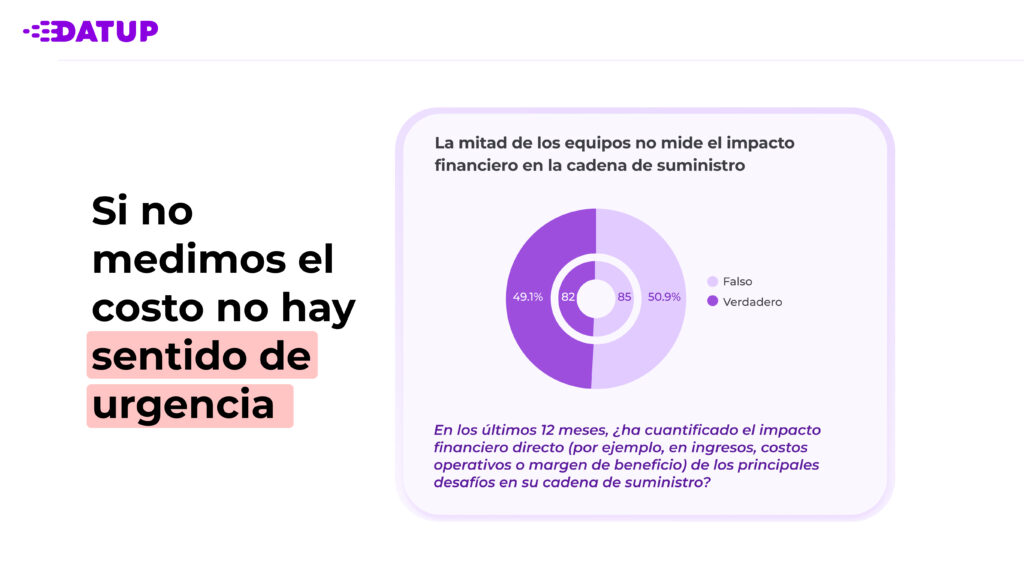
At Datup, we conducted one of the most comprehensive studies on trends in digital transformation and supply chain automation in Latin America 2024-2025, where we analyzed the best practices and emerging technologies in More than 167 companies Within 15 countries, encompassing 12 different industries And organizations from less than USD 10M up to more than USD 100M in annual billing.
Do you want to know the technologies and strategies being implemented by leaders in supply chains in Latin America? Download our full study now and discover the key insights that are transforming the industry in 2025.
In our analysis of 167 companies in Latin America in the supply chain, we found that while some organizations are taking advantage of these opportunities to transform, others are struggling to take the first steps. The data show a clear division: while 25% have already implemented advanced digital technologies, 17% still rely exclusively on Excel and manual processes.
This gap doesn't just affect operational efficiency — it's redefining competitiveness in the region. Companies that succeed in adopting these technologies not only improve their operations, but they gain the ability to anticipate and adapt quickly to market changes.
These are the seven trends that are setting the course of digital transformation in Latin American supply chains:
71.9% of companies aim to implement predictive and prescriptive analytics, seeking Improve the accuracy of your demand forecasts. This high interest responds to a critical problem: 58.1% of companies identify errors in determining demand as their main headache.
However, today only 11.9% use AI/ML solutions effectively. This gap between aspiration and reality suggests that many companies underestimate the requirements to implement these technologies, especially in terms of data quality and technical capabilities of the team.
In fact, not all teams are ready to integrate artificial intelligence and models of Machine Learning predictive.
53 companies are considering cloud computing as a key part of their digital strategy. This trend responds to a critical need: the integration of existing systems, which 63.5% of companies identify as one of their main obstacles.
The cloud not only promises greater scalability and access to real-time data, but it also makes it easier to connect between different systems and departments. Companies see the cloud as a solution to unify their operations and obtain a complete view of their supply chain.
70% of the surveyed teams already have an ERP in place, creating a solid base for moving towards more sophisticated technologies. This mass adoption shows that companies understand the importance of having a robust core system before venturing into more advanced technologies.
Having a mature implementation of an ERP is very important because it enables the integration of predictive analytics models. This is because there is a structure in the data and the systems are integrated together, making it easier to improve the technological capabilities that allow us to integrate models that allow:
Of the 167 companies surveyed in Latin America, 23.4% are exploring advanced simulation using digital twins — a technology that creates a virtual copy of the supply chain to test scenarios before implementing them in real life.
Digital twins are especially helping in two areas where companies lose money the most: scenario planning and inventory optimization. And it makes sense — when 43.7% of companies have overstock problems and 55.1% suffer inventory failures, being able to simulate different strategies before implementing them can mean millions of dollars in savings.
In fact, among the companies surveyed, digital twins are rapidly moving from being an “interesting” technology to a practical tool for solving real supply chain problems. The ability to test and adjust strategies in a virtual environment before implementing them is changing how companies manage their operations.
A clear trend in the study is the movement towards the democratization of data. While 77.24% of staff are learning or moderately prepared to adopt technologies, companies are investing in making data more accessible and useful for all levels of the organization.
This trend seeks to solve two fundamental problems identified in the study: information processing overload (55.7%) and decision-making errors (37.1%). By giving access to data and analytical tools to more people in the organization, companies seek to accelerate decision-making and improve their accuracy.
RPA (Robotic Process Automation) is a technology that allows you to automate repetitive tasks that people normally perform on their computers — for example, copying data from Excel to a system, generating daily reports, or sending inventory updates. It's like having a “digital robot” that does this routine work for you.
The numbers are clear: 61 companies say they are “considering” implementing these digital robots and only 8.4% have done so. Meanwhile, most teams are still spending hours on manual tasks that could be automated. It's not just an issue of efficiency — while teams waste time copying and pasting data, they neglect what's important: analyzing information and improving customer service.
20.4% of companies already use IoT, mainly to improve visibility and traceability in their operations. This adoption is directly linked to one of the main aspirations of supply chain teams: to have end-to-end visibility in real time.
The implementation of IoT is helping companies overcome one of their biggest challenges: the lack of reliable and timely data. With connected sensors and devices, organizations can monitor their operations in real time and make decisions based on up-to-date data.
Predicting demand remains the big challenge. 58.1% of the companies surveyed identify it as their main headache, and that's no wonder — prediction errors trigger a series of cascading problems that affect the entire operation.
But the real problem goes beyond numbers. When we delve deeper into the interviews, we find a pattern: teams are overloaded processing information (55.7%) instead of analyzing it. They spend hours updating reports and consolidating data, while real problems — such as Inventory bankruptcies (55.1%) and the overstock (43.7%) — remain unresolved.

Teams are stuck in a vicious cycle: they spend so much time on operational tasks that they can't focus on improving their prediction processes. And without better forecasts, operational problems only increase.
At first glance, the problem seems to be money — 61.7% cite costs as their main barrier. But as we delve deeper into the data, a more complex reality emerges:
The real bottleneck lies in integration. 63.5% of companies fail to make their systems talk to each other. They have data, they have systems, but they are isolated in silos that make it difficult to have a complete view of the operation.
Exchange resistance (49.7%) and lack of technical knowledge (39.5%) are two sides of the same coin. Teams want to improve, but they fear that new technologies will make their already overburdened daily lives more complicated.
The teams' aspirations are clear and practical:
It's not just about seeing the data — they want to understand what's happening at every point in their supply chain when it's happening. From in-transit inventory to service levels, visibility is the foundation for everything else.
Have total control from predicting demand to delivering the final product to B2B and B2C customers...
Director of Retail
Teams seek to move from “putting out fires” to preventing them. They want tools that not only show historical trends, but that help to anticipate problems and opportunities.
We want to anticipate demand and have the right portfolio of products with the right inventory level for an optimal level of service.
— Director of Retail
It's not about automating for the sake of automating. Teams want to free up time from repetitive tasks to focus on what really matters: strategic analysis and continuous improvement.
Greater purchasing agility with efficient RPA systems. Improve projection software. Work in an integrated way on demand buying models.
Sourcing Leader, Hardware and Construction Industry
The good news is that most of these aspirations are achievable with existing technology. The real challenge is not technological, but rather one of data governance, implementation and cultural change.
The concern about the loss of competitiveness (39.5%) is not abstract — companies are seeing how more agile competitors win their market. The increase in operating costs (31.1%) is only the visible part of the problem.
What is really at stake is the ability to adapt. Companies that don't transform don't just spend more — They lose the ability to respond quickly to changes in the market. In a world where customer expectations are constantly changing, this rigidity can mean large losses in the market.
The message from the data is clear: digital transformation is no longer a technology project — it's a business need. Companies that don't take this step not only risk being left behind, but becoming irrelevant in an increasingly dynamic market.
According to the study, when we asked “Over the past 12 months, have you quantified the direct financial impact (for example, on revenues, operating costs, or profit margin) of major challenges in your supply chain?” , the results were divided into almost equal parts.
This lack of measurement has serious consequences:

Before embarking on any digital transformation initiative:

Only when you have these numbers, you can:
From the analysis of the indicators mentioned by the supply chain teams, we found that:
25.45% focus on service indicators such as OTIF (On Time In Full), Fill Rate and delivery compliance. Inventory indicators are in second place with 22.73%, including inventory days, turnover, and stock levels. Financial indicators represent 21.82%, with metrics such as ROI and logistics costs on sales. Surprisingly, Only 10% measure indicators related to demand forecasting on a recurring basis, despite being the most mentioned challenge.

This distribution suggests that teams are more focused on measuring consequences (level of service and inventory) than root causes (accuracy in prediction). Operational efficiency and costs take up less space, with 8.18% and 5.45% respectively, which could explain why many companies struggle to justify investments in technology.
Before jumping to advanced solutions, ensure that your data is reliable and integrated. 63.5% of companies struggle with system integration — solving this first will save you headaches later.

Demand forecasting is the number one challenge for 58.1% of companies. If you are going to invest, start here. A 1% improvement in the accuracy of your forecasts can mean significant savings in inventory.
You don't need a complete transformation to get started. 55.7% of teams are overloaded with information processing — identify repetitive tasks that you can automate today with simple tools.
Technology is only part of the equation. 49.7% face resistance to change and 39.5% lack technical knowledge. Dedicate time and resources to empower your team—they're the ones who will make the transformation work.
Maybe you’d be interested in learning about the best tools for supply chain optimization.
It's not all technology. Define what success means for your operation:
.png)
.png)
.png)

